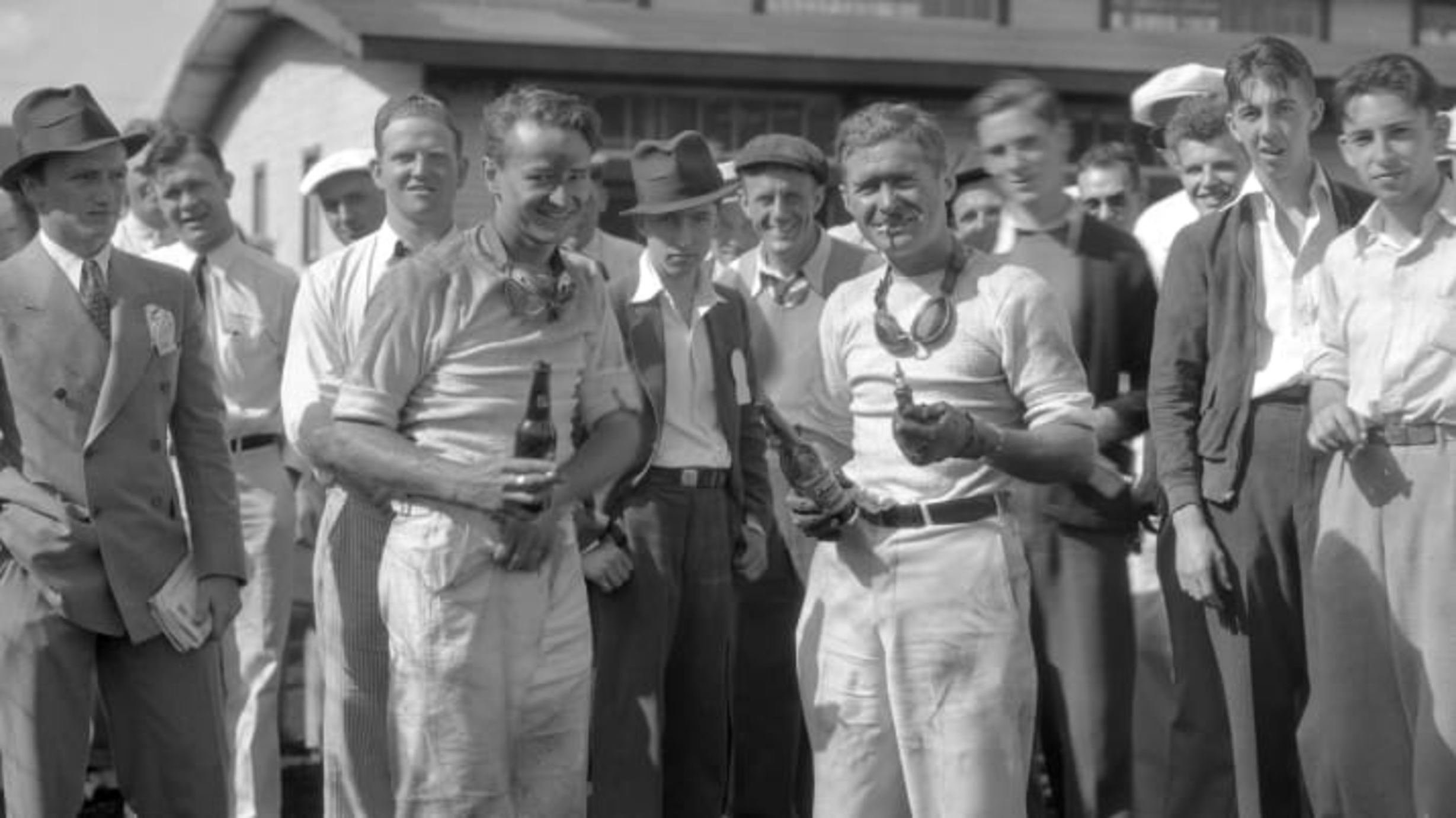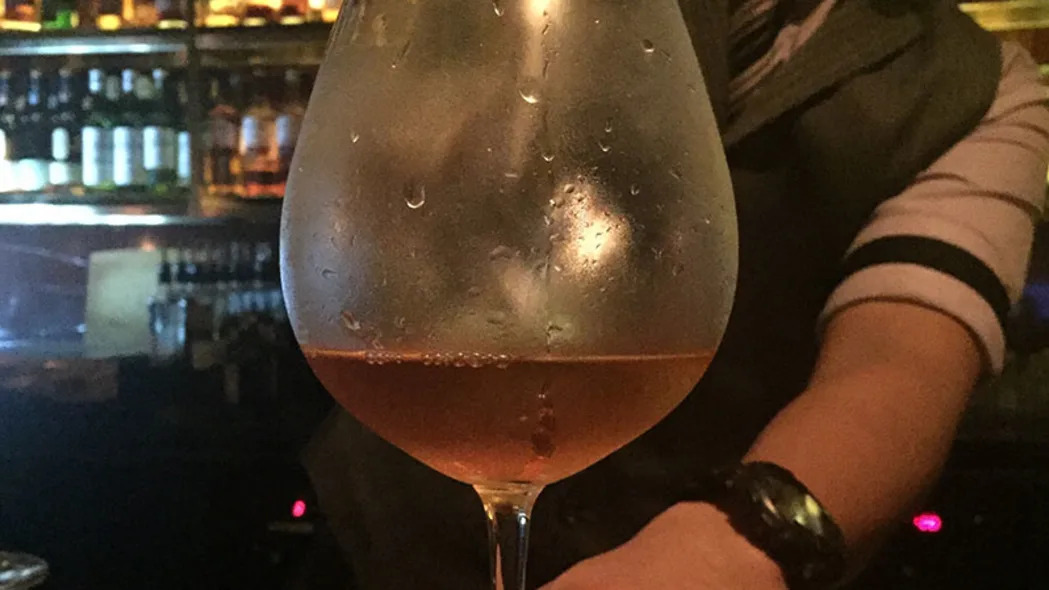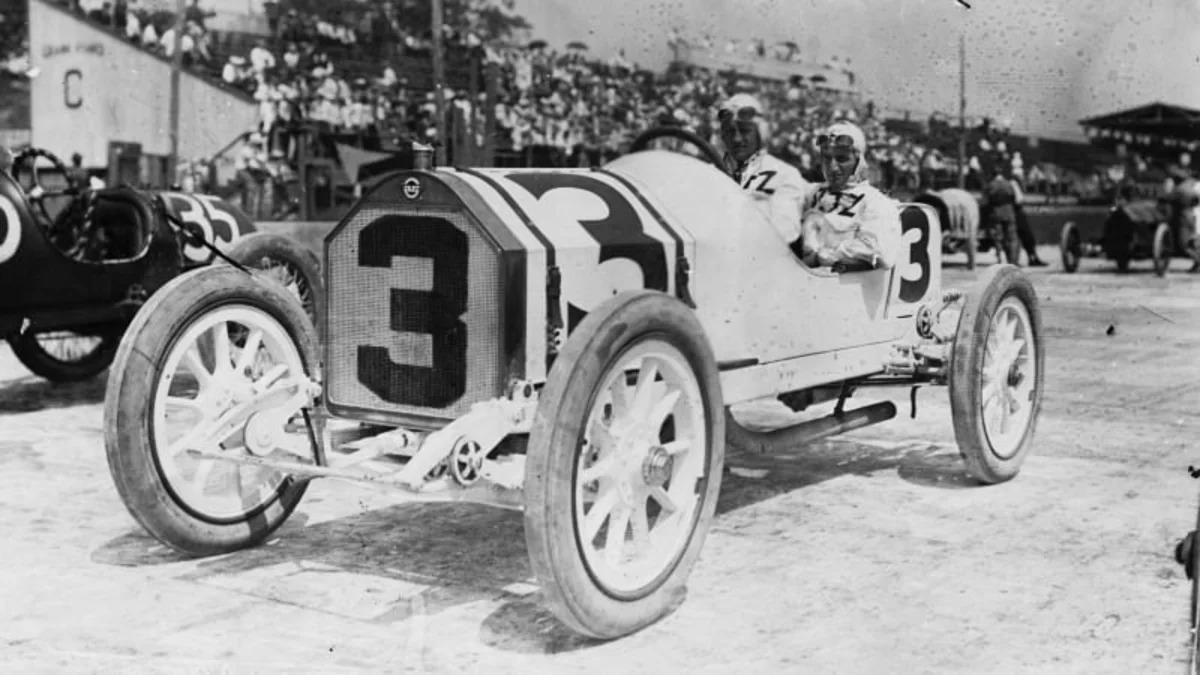In our last installment of the irregular and irreverent series on drinks loosely connected to – or named after – automobiles, we slurped a Pink Cadillac margarita, a tooth-rotting concoction that is definitely not the Cadillac of cocktails. This time, we're celebrating an upcoming motorsport occasion with a high-octane cocktail turbocharged with a wine glass full of whiskey. And, as always, enjoy cocktails (and reading about them) while you're not behind the wheel.
Spring means discovering forgotten yardwork under the slush, washing the goddamn windows, and trying to get the Fiat running. It also means IndyCar, and our incipient dread at receiving another invitation to the Indianapolis 500. Unlike many of our peers here at Autoblog, we think racing is just a lot of insolent noise. And beer, which we also can't abide. But we're nothing if not intrepid in our quest for alternative means to connect with the sport, or at least dull the pain of attendance. So in preparation for this year's race season, like the resurfacers at the Brickyard, we dug up the Speedway.
This archaic concoction, from the 1913 Bartenders Association of America Manual, enticed us with its first ingredient, "a wineglass of Irish Whisky." We nearly lost consciousness right then, but persisted in reading the recipe, which also included a Morse code of dashes: two of maraschino liqueur, three of orange bitters, four of absinthe.
Before getting to the bottom of that wine glass, we needed to get to the bottom of this drink's origins. So, as is our way, we rounded up some imbibing experts.
"I was just in Singapore on a cocktail tour and asked head bartender Cedric Mendoza from the Manhattan Bar in the Regent what he thought of the recipe," says our intrepid Asian cocktailista Nick Coldicott, who recently named the locale as one of the World's 50 Best Bars. "He saw it as a Sazerac variation," Coldicott says, referring to one of America's oldest native cocktails, which also features whisky, absinthe, and bitters.
Variations have always been a means of creating new drinks. A Rob Roy is a Manhattan made with scotch instead of rye. A Boulevardier is a Negroni made with rye instead of gin. A Bronx is a Screwdriver made with gin instead of vodka. But what interests us here isn't so much the mix as the moniker. Is this thing named for the famous track?
"I suspect it originated from the Indianapolis Speedway, because the listing from 1913 times perfectly just after the opening of the Speedway, which opened in 1909 and was the first dedicated motor speedway to open in the US," opines Conor Sweeney, portfolio manager for venerable Irish whiskey distiller Teeling, which got its start in Dublin in 1782.

"I also speculate, because of the cocktail's recipe – containing a full wine glass of whiskey and other alcoholic ingredients – it might refer to the intense nature of the Speedway when it first opened. Because back then, there were a lot of accidents, a lot of people crashed, spectators were injured. It seems like it's a fitting cocktail for the time."
Sweeney went on to educate us on Irish whiskey, the reputation of which was far more elevated back in the early twentieth century than it is now. "Irish whiskey was prominent up until about the end of World War I, which coincided roughly with Irish independence from the UK, and the start of Prohibition."
Charmed as we were by Sweeny's Irish brogue, and clever guesswork, we were still uncertain of the drink's nomenclatural provenance. So we decided to act locally, and call Richard Edwards, the general manager of St. Elmo Steakhouse, the oldest such establishment in Indianapolis. Dating to 1902, it predates both the brick and liquid Speedways. Sadly, it was a bust.
"I spoke with our sommelier and our bartenders," Edwards tells us. "We're all fans of classic cocktails, but, unfortunately, no one knows of that one." If you ever visit, be sure to order one.
A peek into the local newspaper archives uncovered a report about the then-new track in Indianapolis, from a 1911 Philadelphia Inquirer article. It mentioned a drink with the same name, but as a joke. The essayist claims to see a sign in a local tavern for a Speedway Cocktail, and when he asks the barkeep for the recipe, he's told, "It's just a glass of gasoline with a nut in it, and you drink it fast." Har-har.
Delving deeper, we discovered a liquor store ad from 1915 in the Indianapolis News that alerted customers to a new concoction called Speedway Cocktail. So someone was serving something alcoholic with that name locally back then. Sadly, no further details are provided, and the stuff came pre-bottled, which seems suspect for any proper cocktail.
In a last ditch effort to solve this riddle, we got on the horn with Donald Davidson, the official historian of the Indianapolis Motor Speedway. Sadly, Davidson knew of no specific connection between the drink and the track, but didn't rule it out, given that the timing seemed proper and that Indy was probably the most prominent of the early race sites.
"As applied to race tracks, I don't know if Indianapolis was the first one to use the term Speedway, but it was one of the first," Davidson says. Being a historian, he then offered us a history lesson. "Apparently the term speedway is nautical. It comes from a fairly narrow canal where the tugboats could be towed from a path nearby, pulled either by humans or by a horse. That path was known as the speedway. Which didn't seem to make any sense, because how fast could you go, three miles per hour?" Speed is relative.

What Davidson was certain of was the provenance of a Speedway Cocktail of a different variety, a secret formula engine oil additive of that name created by Indy racecar engineer Joe Lencki back in the 1940s. "Hot rodding was huge back then, and there were all kinds of products that were the greatest thing ever invented, and they all had neat names – Lubrilloid, Cupsilloid," Davidson says. "Whether they were any good or not, who knows?" (Lencki later tried to peddle a gasoline replacement that would yield 100 miles per gallon, but had to be burned in his proprietary engine, so, we guess that the answer is, "Not".)
As for the potable Speedway Cocktail, continuing the tradition of this column, we whipped up a round to test drive. Conor Sweeney suggested we use Teeling's small batch Irish Whiskey, which has a slight nose of banana from the rum casks in which its aged. But we couldn't find it at our local liquor store so we chose Jameson Black Barrel, which is a bit spicy with a vanilla finish. Cedric was right, it was very sazerac-y, though less medicinal, more robustly sweet, and, like all things we love, featuring a slightly nutty undertone of bitterness. The balance was very interesting, though given the more ambrosial whiskey; we'd recommend one fewer dash of absinthe.

Cedric did us the favor of coming up with his own version of the drink as well (pictured above), adding a few new ingredients – you do have a smoke gun at home, right? Caldicott sampled it, served "on-the-rock," over one giant hand-carved ice cube, in a burgundy glass. And, after a sip, deemed it exceptional. "An amazing balance of herbs, honey, and smoke." Kind of like an Indy race.
Cedric Mendoza's Singapore Speedway
60ml Red Breast Irish Whiskey 12 yrs
2 dashes maraschino
1 dash of orange bitters
2 dashes absinthe
2 dashes of Drambuie
Twist of lemon
Small blast of wild cherry bark from the smoke gun
Related Video:
Spring means discovering forgotten yardwork under the slush, washing the goddamn windows, and trying to get the Fiat running. It also means IndyCar, and our incipient dread at receiving another invitation to the Indianapolis 500. Unlike many of our peers here at Autoblog, we think racing is just a lot of insolent noise. And beer, which we also can't abide. But we're nothing if not intrepid in our quest for alternative means to connect with the sport, or at least dull the pain of attendance. So in preparation for this year's race season, like the resurfacers at the Brickyard, we dug up the Speedway.
This archaic concoction, from the 1913 Bartenders Association of America Manual, enticed us with its first ingredient, "a wineglass of Irish Whisky." We nearly lost consciousness right then, but persisted in reading the recipe, which also included a Morse code of dashes: two of maraschino liqueur, three of orange bitters, four of absinthe.
Before getting to the bottom of that wine glass, we needed to get to the bottom of this drink's origins. So, as is our way, we rounded up some imbibing experts.
"I was just in Singapore on a cocktail tour and asked head bartender Cedric Mendoza from the Manhattan Bar in the Regent what he thought of the recipe," says our intrepid Asian cocktailista Nick Coldicott, who recently named the locale as one of the World's 50 Best Bars. "He saw it as a Sazerac variation," Coldicott says, referring to one of America's oldest native cocktails, which also features whisky, absinthe, and bitters.
Variations have always been a means of creating new drinks. A Rob Roy is a Manhattan made with scotch instead of rye. A Boulevardier is a Negroni made with rye instead of gin. A Bronx is a Screwdriver made with gin instead of vodka. But what interests us here isn't so much the mix as the moniker. Is this thing named for the famous track?
"I suspect it originated from the Indianapolis Speedway, because the listing from 1913 times perfectly just after the opening of the Speedway, which opened in 1909 and was the first dedicated motor speedway to open in the US," opines Conor Sweeney, portfolio manager for venerable Irish whiskey distiller Teeling, which got its start in Dublin in 1782.

"I also speculate, because of the cocktail's recipe – containing a full wine glass of whiskey and other alcoholic ingredients – it might refer to the intense nature of the Speedway when it first opened. Because back then, there were a lot of accidents, a lot of people crashed, spectators were injured. It seems like it's a fitting cocktail for the time."
Sweeney went on to educate us on Irish whiskey, the reputation of which was far more elevated back in the early twentieth century than it is now. "Irish whiskey was prominent up until about the end of World War I, which coincided roughly with Irish independence from the UK, and the start of Prohibition."
The liquor's perceived excellence was based in part on the Dublin distilleries' proximity to the British colonial nobility in the city's walled Pale district, and thus to the castoff casks from this elite's quality sherries, ports, and madieras, which were reused for aging the local alcohol. "In the early Teens, Irish whiskey was probably the height of the exports. The US was the biggest market for Irish whiskey then and it still is today.""It seems like it's a fitting cocktail for the time."
Charmed as we were by Sweeny's Irish brogue, and clever guesswork, we were still uncertain of the drink's nomenclatural provenance. So we decided to act locally, and call Richard Edwards, the general manager of St. Elmo Steakhouse, the oldest such establishment in Indianapolis. Dating to 1902, it predates both the brick and liquid Speedways. Sadly, it was a bust.
"I spoke with our sommelier and our bartenders," Edwards tells us. "We're all fans of classic cocktails, but, unfortunately, no one knows of that one." If you ever visit, be sure to order one.
A peek into the local newspaper archives uncovered a report about the then-new track in Indianapolis, from a 1911 Philadelphia Inquirer article. It mentioned a drink with the same name, but as a joke. The essayist claims to see a sign in a local tavern for a Speedway Cocktail, and when he asks the barkeep for the recipe, he's told, "It's just a glass of gasoline with a nut in it, and you drink it fast." Har-har.
Delving deeper, we discovered a liquor store ad from 1915 in the Indianapolis News that alerted customers to a new concoction called Speedway Cocktail. So someone was serving something alcoholic with that name locally back then. Sadly, no further details are provided, and the stuff came pre-bottled, which seems suspect for any proper cocktail.
In a last ditch effort to solve this riddle, we got on the horn with Donald Davidson, the official historian of the Indianapolis Motor Speedway. Sadly, Davidson knew of no specific connection between the drink and the track, but didn't rule it out, given that the timing seemed proper and that Indy was probably the most prominent of the early race sites.
"As applied to race tracks, I don't know if Indianapolis was the first one to use the term Speedway, but it was one of the first," Davidson says. Being a historian, he then offered us a history lesson. "Apparently the term speedway is nautical. It comes from a fairly narrow canal where the tugboats could be towed from a path nearby, pulled either by humans or by a horse. That path was known as the speedway. Which didn't seem to make any sense, because how fast could you go, three miles per hour?" Speed is relative.

What Davidson was certain of was the provenance of a Speedway Cocktail of a different variety, a secret formula engine oil additive of that name created by Indy racecar engineer Joe Lencki back in the 1940s. "Hot rodding was huge back then, and there were all kinds of products that were the greatest thing ever invented, and they all had neat names – Lubrilloid, Cupsilloid," Davidson says. "Whether they were any good or not, who knows?" (Lencki later tried to peddle a gasoline replacement that would yield 100 miles per gallon, but had to be burned in his proprietary engine, so, we guess that the answer is, "Not".)
As for the potable Speedway Cocktail, continuing the tradition of this column, we whipped up a round to test drive. Conor Sweeney suggested we use Teeling's small batch Irish Whiskey, which has a slight nose of banana from the rum casks in which its aged. But we couldn't find it at our local liquor store so we chose Jameson Black Barrel, which is a bit spicy with a vanilla finish. Cedric was right, it was very sazerac-y, though less medicinal, more robustly sweet, and, like all things we love, featuring a slightly nutty undertone of bitterness. The balance was very interesting, though given the more ambrosial whiskey; we'd recommend one fewer dash of absinthe.
Cedric did us the favor of coming up with his own version of the drink as well (pictured above), adding a few new ingredients – you do have a smoke gun at home, right? Caldicott sampled it, served "on-the-rock," over one giant hand-carved ice cube, in a burgundy glass. And, after a sip, deemed it exceptional. "An amazing balance of herbs, honey, and smoke." Kind of like an Indy race.
Cedric Mendoza's Singapore Speedway
60ml Red Breast Irish Whiskey 12 yrs
2 dashes maraschino
1 dash of orange bitters
2 dashes absinthe
2 dashes of Drambuie
Twist of lemon
Small blast of wild cherry bark from the smoke gun
Related Video:


Sign in to post
Please sign in to leave a comment.
Continue